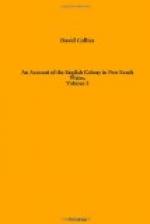Leaving Furneaux’s Islands, the Norfolk proceeded toward the North coast of Van Diemen’s land; and on the 1st of November she anchored for a tide at the largest of the Swan isles, two small islands so named by Lieutenant Flinders, when he was here in the Francis, because a European who belonged to the Sydney Cove had assured him that he had met with vast numbers of breeding swans upon them.
The isle at which the sloop anchored bore a great resemblance to Preservation Island, being low, sandy, and barren, but differed from it in the composition of its rocks, or that substance which formed the basis of its support. This had not any affinity to granite, nor did Mr. Bass remember to have seen any of a similar kind upon any part of New South Wales. It was of various colours, but generally either a light brown, or a sort of grey. It seemed to be lamellated, but the lamellae were placed vertically, sometimes radiated with a diameter of four or five feet, and sometimes they were placed parallel. Upon breaking the stone, the fracture was vitreous, or like that of glass, and it scintillated on steel being applied. Rust of iron was visible in several parts, the stone breaking easily in those parts into plates correspondent to the length and direction of the rust; but where that was not, it broke with great difficulty. On the first view, the stone looked like a clay; but as it produced fire with steel, there must have been a large portion of flint in it. It appeared to contain iron in rather a large quantity, and probably some other metallic substances.
Notwithstanding the information given by the European, not a single swan was found upon the island; but several geese were breeding there, and the sooty petrel possessed the grassy parts; the swans of the sailor, in this instance, therefore, turned out to be geese. This bird had been seen before upon Preservation Island, and was either a Brent or a Barnacle goose, or between the two. It had a long and slender neck, with a small short head, and a rounded crown; a short, thick arched bill, partly covered with a pea-green membrane which soon shrivelled up, and came away in the dried specimens. Its plumage was, for the most part, of a dove colour, set with black spots. It had a deep, hoarse, clanging, and, though a short, yet an inflected voice. In size it was rather less than our tame geese, and lived upon grass. The flesh was excellent.
Early in the morning of the first of November they left the Swan Isles, steering to the westward along shore. At nine o’clock the north coast of Van Diemen’s land lay extended from about SE by E to West, the nearest part of it being distant two and a half or three miles. Its general trending seemed to be about ESE and WNW with a small island lying off the western extreme. The shores were chiefly beaches, the front land was of a moderate height, the back was mountainous. One ridge of mountains that bore south was very high and rugged, and from the white patches in it was concluded to be rocky and barren.




